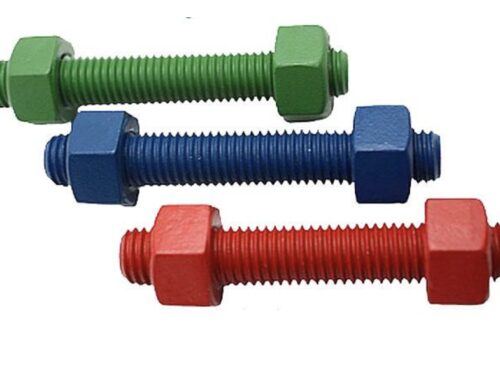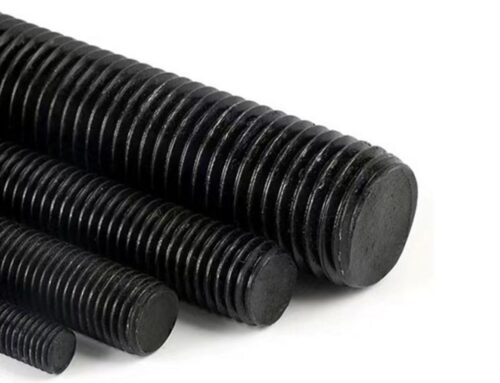Hot Dip Galvanizing Standard for Stud bolt.
Hot-dip galvanizing (HDG) is a process used to coat steel fasteners, such as stud bolts, with a layer of zinc for enhanced corrosion resistance. The process involves dipping the steel into molten zinc, forming a robust, durable, and corrosion-resistant coating. Standards governing hot-dip galvanizing ensure consistency, quality, and performance across applications.
Common Standards for Hot-Dip Galvanizing of Stud Bolts:
- ASTM Standards (USA):
- ASTM A153/A153M: Covers zinc coatings applied by the hot-dip process on iron and steel hardware, including bolts, nuts, and washers.
ASTM A153 A153M Standard Specification for Zinc Coating (Hot-Dip) on Iron and Steel Hardware
This specification covers standards for zinc coatings applied through hot-drip process on iron and steel hardware. The hot-dip galvanizing process shall form layers of Zn/Fe alloy adhering to the steel surface. This specification is applicable to steel hardware items of Classes A, B, C, and D. The thickness or weight/mass of zinc coating shall conform to specified values for various classes of materials. The coated articles shall be free from uncoated areas, blisters, flux deposits, dross inclusions, and other defects. The coating shall be smooth and reasonably uniform in thickness. Tests shall be performed to determine the minimum coating weight or minimum coating thickness, finish and appearance, embrittlement, adherence, average weight/mass of coating, and average thickness of coating. Guidelines are also given for inspection, rejection and retest, packaging, and certification procedures.
Scope
1.1 This specification covers zinc coatings applied by the hot-dip process on iron and steel hardware. The hot-dip galvanizing process consists of parts being immersed in molten zinc for a sufficient time to allow a metallurgical reaction between iron from the steel surface and the molten zinc, resulting in the formation of Zn/Fe alloy layers bonding the coating to the steel surface.
1.2 This specification is intended to be applicable to hardware items that are centrifuged or otherwise handled to remove excess galvanizing bath metal (free zinc). Coating thickness grade requirements reflect this.
1.3 Fasteners that must comply with the Fastener Quality Act require specific statistical sampling during the inspection of the fastener lots. Requirements for the sampling of these fasteners can be found in F2329/F2329M.
1.4 This specification is applicable to orders in either inch-pound units (as A153) or in SI units (as A153M). Inch-pound units and SI units are not necessarily exact equivalents. Within the text of this specification and where appropriate, SI units are shown in brackets. Each system shall be used independently of the other without combining values in any way. In the case of orders in SI units, all testing and inspection shall be done using the metric equivalent of the test or inspection method as appropriate. In the case of orders in SI units, such shall be stated to the galvanizer when the order is placed.
1.5 This standard does not purport to address all of the safety concerns, if any, associated with its use. It is the responsibility of the user of this standard to establish appropriate safety and health practices and determine the applicability of regulatory limitations prior to use.
ASTM A153/A153M specification.
- Coating Requirements:
Specifies the minimum thickness of the zinc coating, which varies depending on the type and size of the item. Coating thickness is measured in terms of weight per unit area (oz/ft²) or microns (µm).- Fasteners and Small Hardware: Minimum average coating of 1.8 oz/ft² (~45 µm).
- Larger Items: Coating thickness may be higher due to surface area differences.
- Adherence:
- The zinc coating must firmly adhere to the steel surface and withstand moderate handling during transportation and installation.
- Finish:
- The coating should be continuous and free from defects like bare spots, lumps, or excessive roughness.
- Testing Methods:
- Coating Thickness: Measured using magnetic or electronic devices.
- Adhesion: Tested by cutting or prying to ensure the coating does not flake or peel.
- Post-Galvanizing Requirements:
- Cleaning or touch-up is permitted for small uncoated areas as long as it complies with specifications.
Table 3
| Thickness or Weight (Mass) of Zinc Coating for Various Classes of Material | ||||
|---|---|---|---|---|
| Weight (Mass) of Zinc Coating, oz/ft2 (g/m2) of Surface, minimum |
Coating Thickness, mils (microns), Minimum |
|||
| Class of Material | Average of Specimens Tested | Any Individual Specimen | verage of Specimens Tested | Any Individual Specimen |
| Class A – Castings – Malleable Iron, Steel | 2.00 (610) | 1.80 (550) | 3.4 (86) | 3.1 (79) |
| Class B – Rolled, Pressed, and Forged articles(except those which would be included under Classes C and D)B-1: > 5/8” (15.88 mm) and > 15” (381 mm) in length | 2.00 (610) | 1.80 (550) | 3.5 (85) | 3.1 (79) |
| B-2: < 5/8” (15.88 mm) and > 15” (381 mm) in length | 1.5 (458) | 1.25 (381) | 2.6 (66) | 2.1 (53) |
| B-3: any thickness and < 15” (381 mm) in length | 1.30 (397) | 1.10 (336) | 2.2 (56) | 1.9 (48) |
| Class C – Fasteners > 3/8” (9.52 mm) in diameter. Washers > 3/16” (4.76 mm) in thickness. | 1.25 (381) | 1.00 (305) | 2.1 (53) | 1.7 (43) |
| Class D – Fasteners < 3/8” (9.52 mm) in diameter. Rivets, nails and similar articles. Washers < 3/16” (4.76 mm) in thickness. | 1.00 (305) | 0.85 (259) | 1.7 (43) | 1.4 (36) |
| Note 1: Length of the piece, stated in Classes B-1, B-2, B-3, refers to the finished dimensions of the piece after fabrication | ||||

